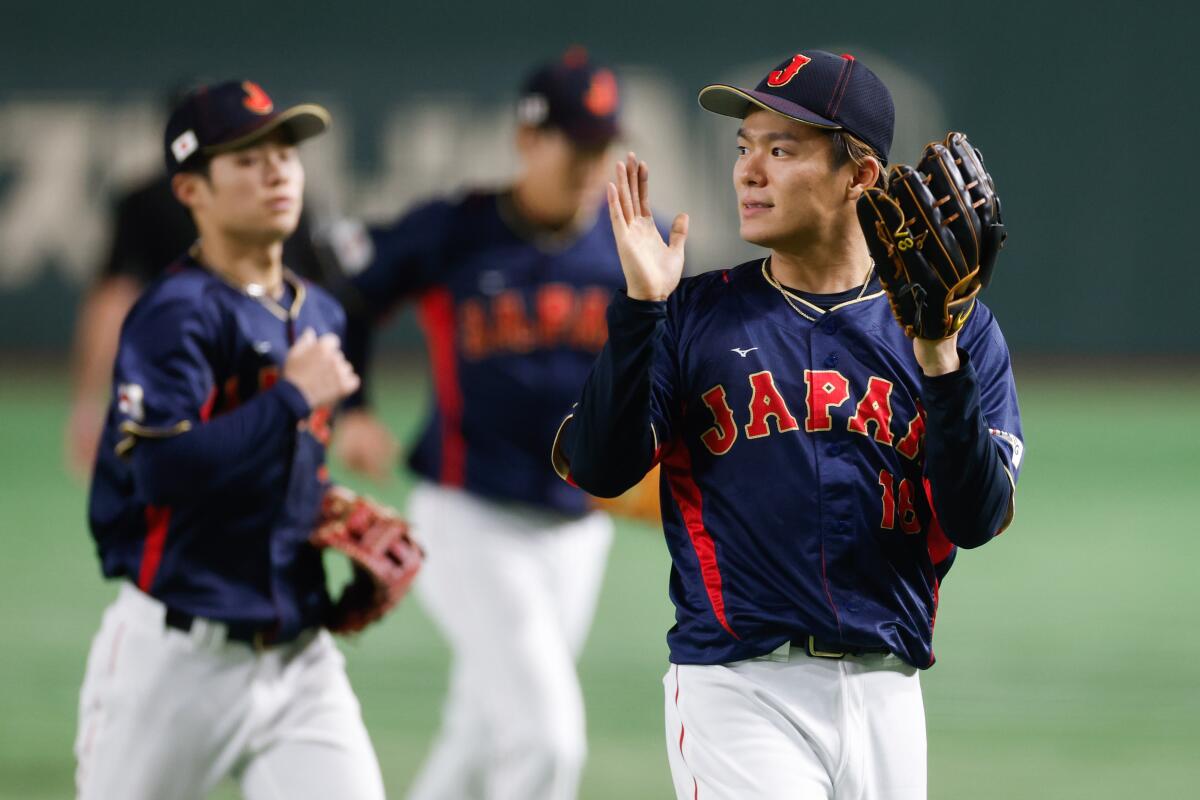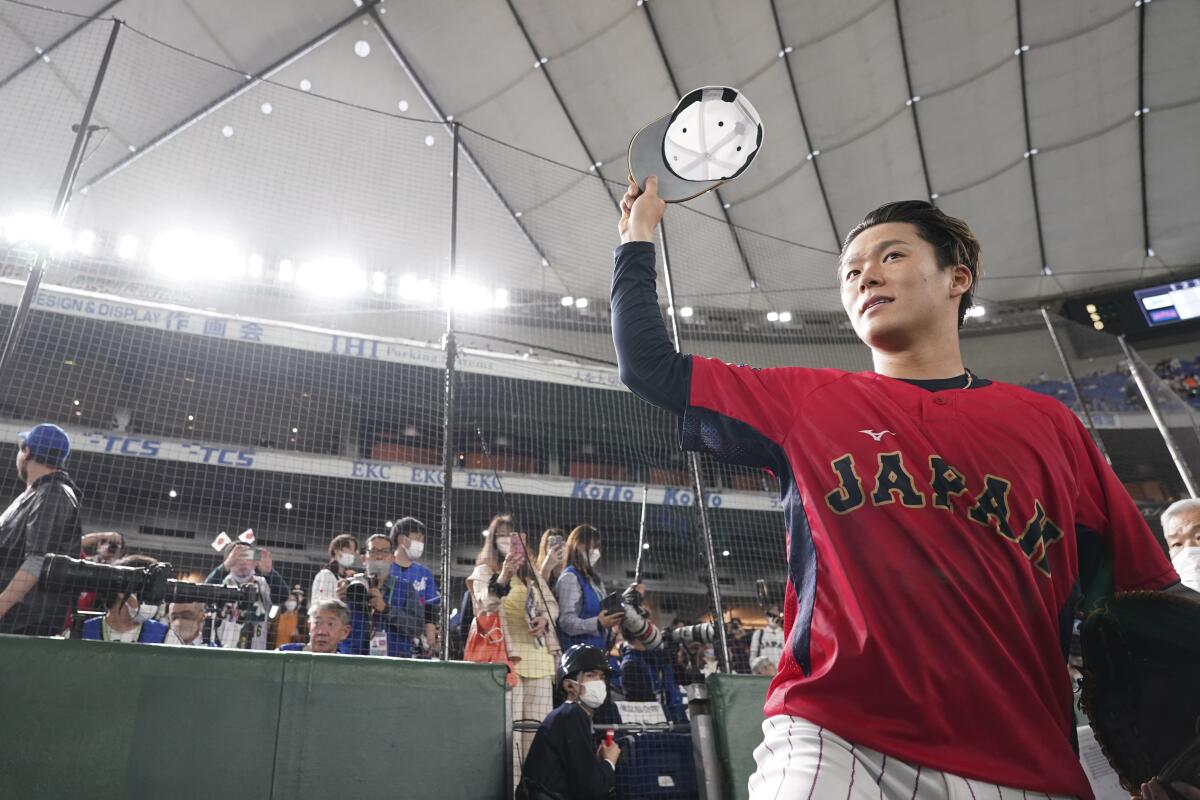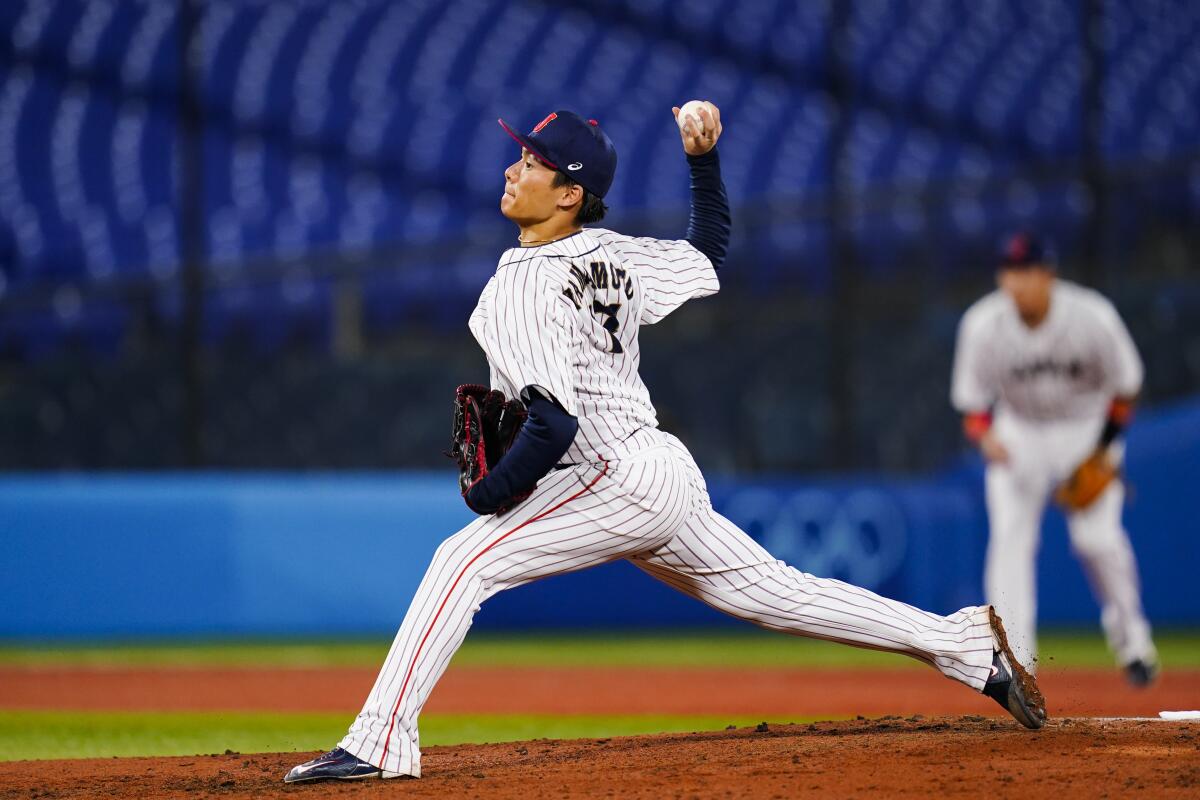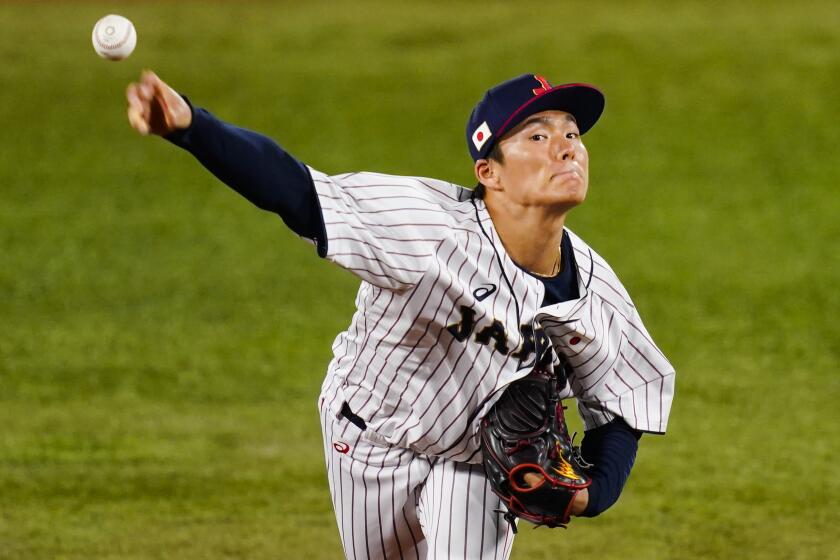Yoshinobu Yamamoto the next Dodgers ace? Scouts praise his skill, question his durability

- Share via
As the center fielder for Team Japan in last spring’s World Baseball Classic, Lars Nootbaar had a unique view of the jaw-dropping four-pitch repertoire of Yoshinobu Yamamoto, the Japanese right-hander who agreed to a 12-year, $325-million deal with the Dodgers on Thursday.
Nootbaar, the St. Louis Cardinals outfielder whose mother is Japanese, marveled at the way Yamamoto’s fastball, which sits in the 94-95-mph range and touches 97 mph with good ride from a lower release point, seemed to “jump out of his hand.”
He described Yamamoto’s split-fingered fastball, which is thrown between 86-92 mph with a 10-inch horizontal break and a late 32-inch drop, as “really gross.” And then there was the big 77-mph curve, which averages 66 inches of vertical drop, and the 93-mph cut-fastball with a slight right-to-left break and an 18-inch drop.
“As a hitter, you try to eliminate so many things and try to focus on one, but with him, he has so many weapons, and they all move so much,” said Nootbaar, the former El Segundo High School and USC standout. “He’s a special pitcher, for sure.”
Hernández: Shohei Ohtani’s $680-million loan to Dodgers made Yoshinobu Yamamoto deal possible
Shohei Ohtani’s $680-million loan to the Dodgers is why the team was able to reach terms on a 12-year, $325-million deal with Yoshinobu Yamamoto.
Nootbaar relished being Yamamoto’s teammate on Japan’s WBC-winning club, and the two became such good friends that Nootbaar traveled to Japan for one of Yamamoto’s playoff starts in late-October and they played golf and hung out together in Southern California this winter.
Nootbaar will likely see Yamamoto again in late March but from a different perspective, one he is not looking forward to as much — the batter’s box in Chavez Ravine, where the Cardinals will open their 2024 season against the Dodgers. Of particular concern for Nootbar will be Yamamoto’s nasty splitter.
“It’s just not fair to have a pitch that moves as much as it does and is as heavy as it seems at the velocity he’s throwing it,” Nootbaar said. “If you have a guy throwing a 91-93-mph fastball, and his splitter is at 82-84 mph, you have a chance because you don’t have to cheat to get to the fastball.
“But when you have a guy who can throw as hard as he does, and you throw the splitter at different velocities, it’s really not fair. Then he’s got that big breaker and the cutter that he plays off those. You’re just kind of at a loss for words when you’re watching it.”
Yamamoto was the third prized piece of a $1.1-billion winter spending spree in which the Dodgers acquired two-way star Shohei Ohtani, who signed a 10-year, $700-million deal, and pitcher Tyler Glasnow, who signed a five-year, $136.5-million deal. The 25-year-old Yamamoto went 70-29 with a 1.82 earned-run average in 172 games over seven seasons for the Orix Buffaloes and 1-0 with a 2.45 ERA and 12 strikeouts in 7-1/3 WBC innings for Japan.
Nootbaar has no doubt that Yamamoto will make a smooth transition to the major leagues and “will be dominant for a long time.”

But exactly how overpowering and how consistently dominant is open to debate. Yamamoto will be paid like baseball’s best pitcher when he passes a physical and his deal with the Dodgers becomes official, but fans shouldn’t expect him to perform like an ace every time he takes the mound.
Scouts, who are not authorized to speak publicly about prospects or players, assessed Yamamoto’s strengths and weaknesses for The Times.
“There will be times he pitches like a No. 1, and he might even throw a no-hitter, but he can be anywhere from a No. 1 to a No. 4,” one veteran major league scout said .
“He has swing-and-miss stuff. He can go after hitters with power and finesse. He has everything you want in a pitcher. The only problem is that he’s small and he hasn’t thrown every fifth day. That’s where the questions come in.”
Pitch-tracking technology has eliminated much of the guesswork in evaluating pitchers from Japan. While there was plenty of mystery and intrigue surrounding Hideo Nomo and Hideki Irabu when they came to the U.S. in the mid-1990s — Nomo to the Dodgers, Irabu to the New York Yankees — Yamamoto is more of a known commodity.
The dozen or so teams that pursued Yamamoto aggressively knew the exact velocity, spin rates, shape and characteristics of all his pitches and the quality of contact — or lack thereof — that each pitch produced.
But another veteran talent evaluator said he doesn’t need any Trackman or Edgertronic data to be convinced that Yamamoto’s stuff will play in the major s. He saw it with his own eyes during several trips to Japan.
“To me, he’s got a great combination of power and precision — he can beat you with velocity, and he can also locate his ass off,” the scout said. “He can go north-south, east-west. He’s gonna beat you up above your hands in the zone with the heater, and the splitter is nasty down. He can flip a good curveball up there — he’ll backdoor it a lot, especially to lefties — and he has that little cutter.
Japanese pitching ace Yoshinobu Yamamoto agreed to a deal with the Dodgers, joining the newly acquired Shohei Ohtani and Tyler Glasnow on the team.
“Is he a No. 1 or a No. 2? I don’t know. I don’t think he’s a true crazy ace, but he’s gonna be one of your first three starters in a playoff series. There are guys with better stuff, but not his combo of stuff and precision, the ability to put the ball where he wants.”
Most concerns about Yamamoto center on his size and potential durability.
Yamamoto, who won Pacific League most valuable player and the Sawamura Award, the Japanese equivalent of the Cy Young Award, in each of the last three seasons, is a less-than-imposing 5 feet 10 and 176 pounds.
A third veteran scout didn’t pull any punches when asked his concerns about a pitcher who is so small and throws so hard.
“UCL tear, eventually,” the scout said of the injury that usually requires Tommy John surgery. “Only question is will it cost you one or two years? Pitching is a damaging action by nature. You factor in a lightning-quick hand and fast arm on a small frame, and those muscles and ligaments have to manage this massive deceleration.”
Shohei Ohtani’s unique contract presents an equally unprecedented business opportunity for the Dodgers to make up to $1 billion over the next decade.
The second scout believes Yamamoto’s clean mechanics and delivery and the strength he packs onto his small frame could mitigate his injury risk.
“You always worry when they’re 5-10, but the difference is, he’s pretty compact,” the scout said. “If he was like [the 5-11, 170-pound] Tim Lincecum, where he was thinner-boned and skinnier, I would worry more about longevity. But to me, he’s like a better version of [5-10, 195-pound] Sonny Gray.”
Japanese teams use six-man rotations, and pitchers start once a week, so the transition to a five-man rotation in the major leagues can be challenging for some.
“Smaller frame, pitching every fifth day, you wonder what the power is going to be like, what the life [on the fastball] is going to be like,” the first scout said. “You might be looking at a 92-94-mph guy, and that life becomes all the more important.”
This shouldn’t be an issue for Yamamoto, though. The Dodgers likely will switch to a six-man rotation when Ohtani returns from Tommy John surgery in 2025, and even last season, when their rotation was ravaged by injuries, pitchers made only 42 starts on four days’ rest, 67 starts on five days’ rest and 44 starts on six or more days’ rest.
“He’s not tall, but he’s strong and durable in his delivery, and everything works good,” the first scout said. “He should stay healthy.”

Nootbaar spent several weeks training with Yamamoto for the WBC and does not believe the pitcher will be more injury prone because of his size.
“He has a unique training style that is not very taxing on his body in terms of heavy weightlifting, but he’s very pliable, he moves very well, and he moves very athletically,” Nootbaar said. “So I’m not that worried about it.”
Yamamoto was close to untouchable in Japan, where he struck out 922, walked 206 and gave up just 36 homers in 897 career innings. He likely will give up more homers in the U.S., where hitters are bigger, stronger and looking to do more damage than hitters in Japan, where contact is king. But don’t expect that to faze him.
“He’s one of the best dudes I’ve ever met — he’s such a great guy — and I think people can mistake that for a little bit of softness,” Nootbaar said. “But he’s a killer, man. He’s an assassin when it comes to competition. He cares, and he works hard, and he wants it bad … he’s basically every team’s dream pitcher.”
Staff writer Dylan Hernández contributed to this story.
More to Read
Are you a true-blue fan?
Get our Dodgers Dugout newsletter for insights, news and much more.
You may occasionally receive promotional content from the Los Angeles Times.














